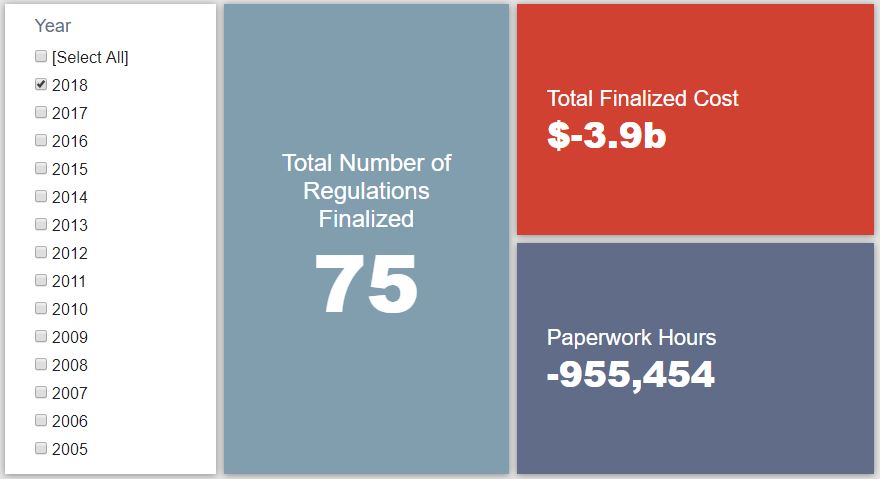Week in Regulation
April 23, 2018
A Deregulatory Spike
Building upon the prior week’s $300 million in savings, this past week in regulation saw even more ambitious deregulatory actions. A pair of health care rules drove most of the savings. Between both proposed and final rules, agencies published roughly $1.6 billion in net cost savings and cut 112,665 hours of paperwork. The per capita regulatory burden for 2018 is negative $11.83.
Regulatory Toplines
- New Proposed Rules: 50
- New Final Rules: 61
- 2018 Total Pages of Regulation: 17,402
- 2018 Final Rules: -$3.9 Billion
- 2018 Proposed Rules: -$3 Billion
Tracking Regulatory Modernization
Two rules from the Centers for Medicare and Medicaid Services (CMS) led the deregulatory surge last week. The first measure adjusts the Medicare Advantage and Part D programs under the auspices of the “Comprehensive Addiction and Recovery Act of 2016,” with a particular eye for mitigating the opioid crisis. It could bring roughly $1.5 billion in total savings, or $365 million annually for the purposes of the Executive Order (EO) 13,771 “regulatory budget.” The second CMS rule finalizes the “Notice of Benefit and Payment Parameters for 2019” that apply to Affordable Care Act exchange plans. This year’s edition of the annually updated regulatory program seeks to provide greater “flexibility,” and produces roughly $123 million in total savings going forward.
According to AAF analysis, since the start of FY 2018 (beginning Oct. 1, 2017), executive agencies have promulgated 33 deregulatory actions with quantified cost savings against five regulatory measures that impose costs, under the rubric created by EO 13,771 and the administration’s subsequent guidance document on the matter. These rules combine for net annual savings of roughly $1.1 billion. This means that agencies have thus far surpassed the administration’s cumulative goal for FY 2018 of $687 million in net annual savings.
Click here to view AAF’s examination of the administration’s progress under the “one-in, two-out” executive order through the end of Fiscal Year 2017.
State of Major Obama-Era Initiatives
The Benefit and Payment Parameters rule mentioned above – and its underlying reform measures – stems from President Trump’s EO 13,765 directing all relevant agencies to “exercise all authority and discretion available to them to waive, defer, grant exemptions from, or delay the implementation of any provision or requirement” under the Affordable Care Act. This rule slightly reduces the overall cost burden imposed by regulations under that law. Based on total lifetime costs of the regulations, the Affordable Care Act has imposed costs of $52.9 billion in final state and private-sector burdens and 176.9 million annual paperwork hours.
Since passage, the Dodd-Frank financial reform legislation has produced more than 82.9 million final paperwork burden hours and imposed $38.9 billion in direct compliance costs.
Total Burdens
Since January 1, the federal government has published $6.8 billion in net costs savings ($3.9 billion from final rules) and new paperwork burdens amounting to 1.3 million hours (however, this includes 955,454 hours cut under final rules). Click here for the latest Reg Rodeo findings.











